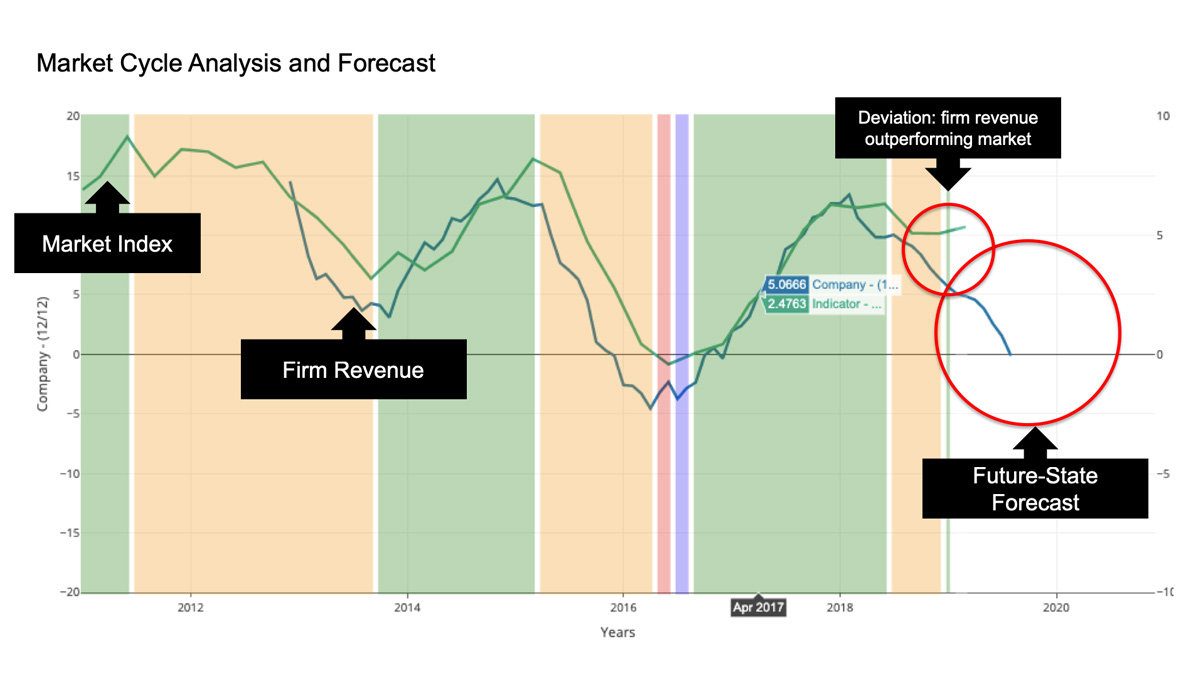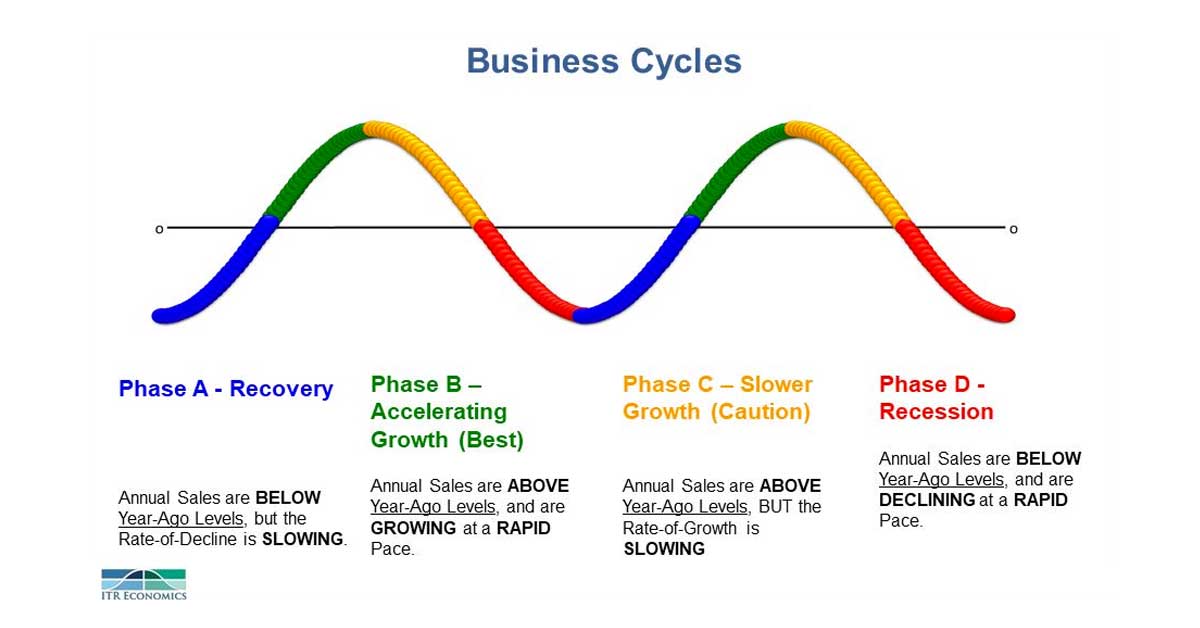Why Your Manufacturing Firm Needs a Market Cycle Analysis
By James Dorn, President
As a manufacturing executive, keeping tabs on your firm’s performance is in your blood. It’s what motivates you — and what keeps you up at night. Because of this, you likely have a keen understanding of your organization’s year-over-year KPIs and current-state performance. Armed with that information, you may think you have everything you need to forecast next year’s numbers and make informed business decisions. But unless you intentionally correlate your historic revenue growth patterns to broader market cycles, your future-state projections will be of limited usefulness.
If you want to pinpoint revenue targets, drive strategic initiatives more effectively, and guide smart investments, you need to understand where the markets are heading. And, whether your core markets are speeding up or stalling out, you need to know how best to respond to those market realities to keep your business ahead of the curve.
The Importance of Market Cycle Analyses During an Economic Slow-Down
Market cycle analysis is a critical tool for manufacturers regardless of how the economy is tracking. But they often don’t discover how useful it is until times get a little tough. After all, when the markets are up, everyone wins. Sure, you can win bigger if you’re strategic and play your cards right. But in times of growth, the odds are in your favor. The real challenges come when market demand cycles down — as it is currently doing for many in industrial manufacturing.
Over the course of 2019, manufacturers saw demand for their products decline relative to the previous year. Instinctively, they know that certain markets are slowing. They may attempt to prove this hunch by following one or two market indexes, using ad-hoc comparative benchmarking or having conversations with others in the industry. While this information is valuable, it only goes so far. Without a more rigorous, data-driven framework, there’s still plenty of room for error and false positives.
A market cycle analysis gives you a data-driven picture of the markets your business is most closely correlated with and how those markets are trending. As a business, your strategic growth strategy should change depending on what your market cycle analysis reveals. Whether you find yourself in a period of slowing or accelerated growth, anticipating growth cycles allows you to proactively chart the most appropriate path forward.
For example, in a down-shifting market cycle, it’s much harder for manufacturers to outpace market growth rates. Doing so requires firms to capture competitive market share (rather than grabbing new market share as it emerges and expands). Most firms find it extremely difficult to do this organically. Instead, they must find something unique to set their company apart and do it better than the competition can. In this scenario, winning may require a big bet.
Without the advantage of a market cycle analysis, you may not discover an important trend like slowing growth until it’s too late from a strategic planning perspective.
Market Cycle Analysis: How it Works
Manufacturing leaders who want to make data-driven decisions need a formal market cycle analysis. Doing so involves tracking the performance of individual markets (such as auto, food and beverage, and aerospace) and correlating them with your business’s own historic revenue trends to produce meaningful insights.
By partnering with ITR Economics, our clients gain access to a comprehensive library of market-specific data. ITR monitors numerous markets, identifies current growth cycles and provides yearly forecasts for the next 3 years.
We begin the process of performing a market cycle analysis by trending out our clients’ year-over-year revenue numbers. Next, using ITR’s database, we compare their unique revenue patterns against over 900 market indexes to find the strongest areas of correlation.

For example, let’s say that a firm’s revenue correlates most strongly with the automotive industry. We can then plot the firm’s revenue against that of the auto industry over a period of several years and look for meaningful overlaps and deviations. Instances in which the firm outperformed the market can yield insights regarding the most promising tactics. Dips, on the other hand, are instructive in learning how to avoid future missteps. Finally, by looking at the auto industry’s market cycle forecast, we can create a strategic plan that allows our clients to respond proactively rather than defensively.
Our analysis includes more than just our clients’ overall revenue. We dig deeper by segmenting revenue by market, channel, product segment, customer segment, and the like. This process often exposes market correlations that our clients weren’t previously aware of. For example, they might discover that their business is meaningfully connected to the oil and gas industry via ancillary markets. This knowledge enables our clients to plan for each segment in the most optimized manner possible.
Another benefit of a market cycle analysis is that it allows manufacturers to see what’s ahead. This is extremely helpful for scenario planning, as it gives firms the ability to proactively adjust course depending on where the markets are going.
Planning for the Four Economic Growth Cycles
In any market, there are four distinct economic growth cycles that emerge cyclically over time. Once you know which markets your firm is mostly strongly correlated with, you can identify which economic growth cycle you are currently in, and which one you are projected to enter next. Your strategic plans should be tailored around these economic realities. The four growth cycles include:
- Accelerated growth
- Slowing growth
- Recession
- Recovery

Part of our work with clients involves helping them identify best practices for strategic planning around each growth cycle. As previously mentioned, during a slowing growth phase it’s wise to consider pursuing growth inorganically. This may mean acquiring another firm in an ancillary market with a higher growth rate. Or it could mean investing more heavily in the individual revenue segments that show the healthiest growth rates. Accelerated growth periods are all about operating at top capacity in terms of productivity and innovation to capture as much market share as possible. During a recession, on the other hand, you must scour your organization for operational efficiencies and improvements. And during a recovery, you should ramp up production and sales and marketing resources in anticipation of accelerated growth.
Want to learn more about how your firm’s historic revenue trends can be applied to market indexes to yield rich strategic insights? Let’s start the discussion.




